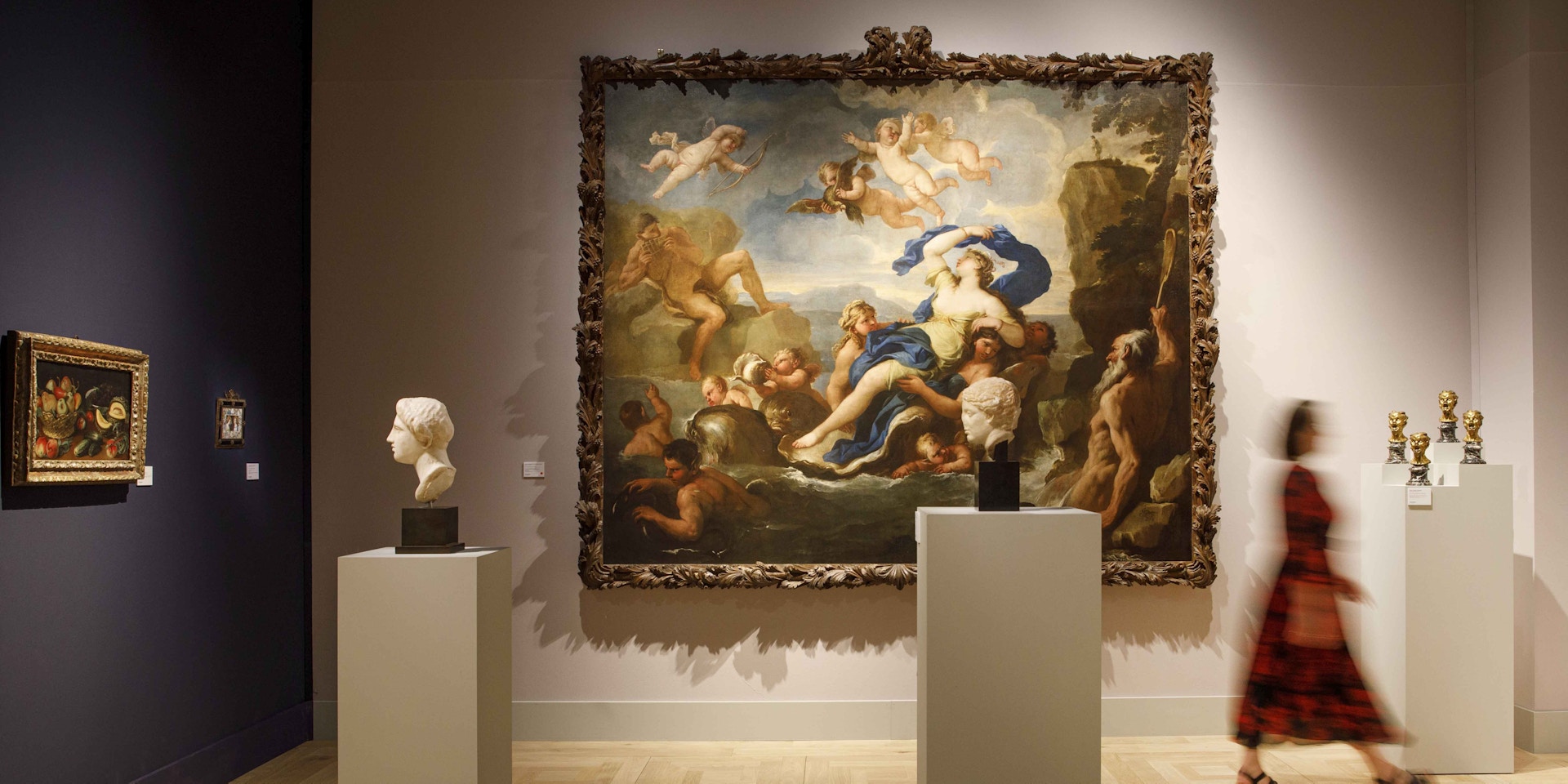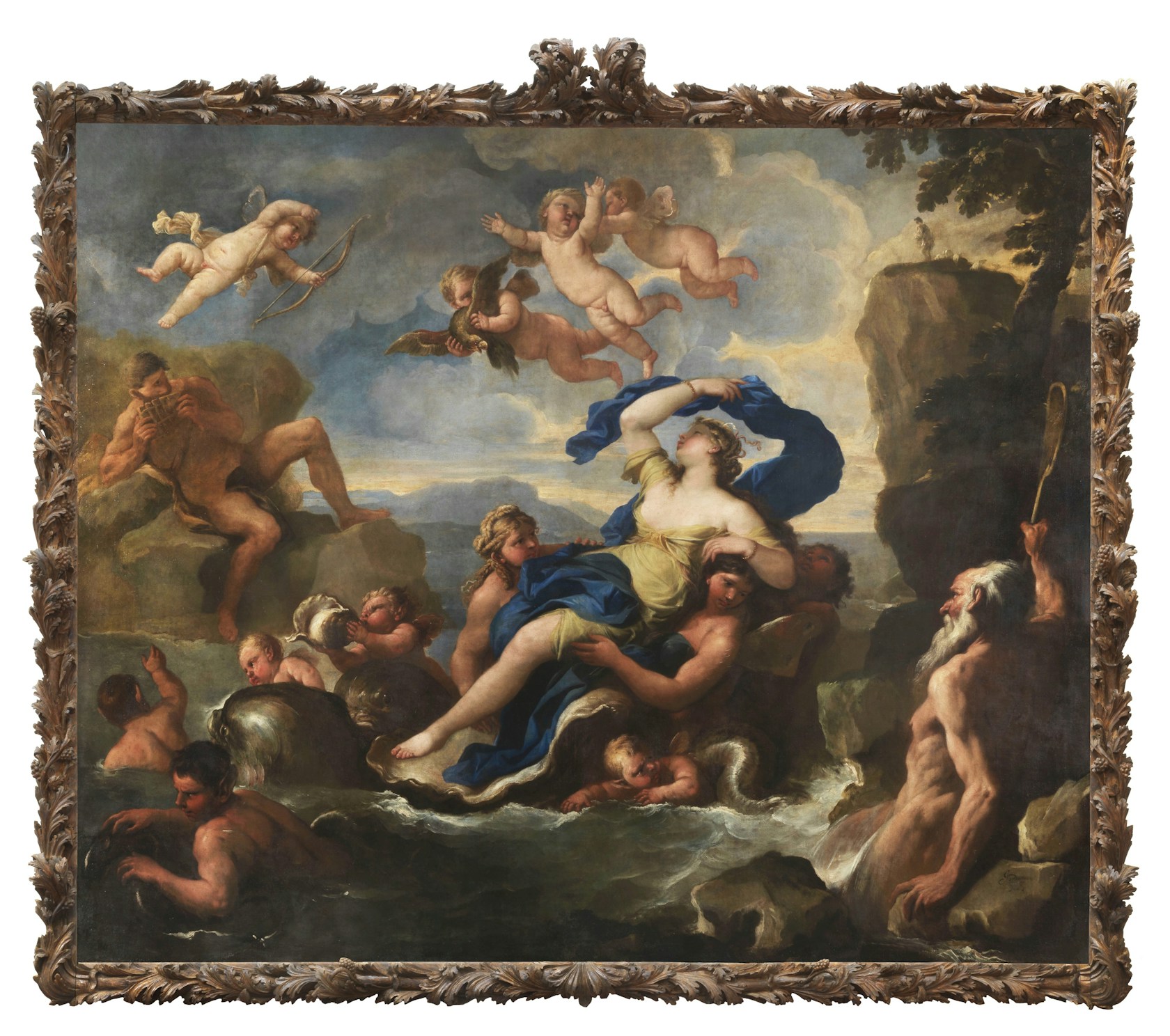
Luca Giordano, The Thriumph of Galatea, c. 1675. Presented by Colnaghi during TEFAF Maastricht 2022, the painting is now in the collection of the Dallas Museum of Art. Photo: Loraine Bodewes.
The Triumph of Luca Giordano
The remarkable “Triumph of Galatea” was the first painting by the leading Italian Baroque artist to join the collection of the Dallas Museum of Art
- By Malin Ebbing
- Museum Stories
During Maastricht 2022, Colnaghi presented the grand and elaborate The Triumph of Galatea (c. 1675) by Luca Giordano (1634–1705). “It was a painting you couldn’t miss in the fair due to its size. It was kind of a magnet. The fact that it had its original Venetian frame made it more like an object, like a jewel,” says Jorge Coll, Executive Director of Colnaghi.
Founded in 1760, Colnaghi is among the oldest commercial art galleries in the world, and one of the few specialising in works of art from antiquity to the present day. With an initial focus on Old Master paintings and sculpture, prints and drawings—selling masterpieces to the great collectors and museums of the Gilded Age—today Colnaghi deals in objects from the ancient world and Old Master, modern and contemporary works, from its galleries in London, New York, Brussels, and Madrid. Coll shares that it was through their extensive network of collaborators that Colnaghi came across the remarkable painting by Giordano: “We have great connoisseurs who, anytime they discover something in a collection, at auction, or with a dealer, they contact us. In this case, collaborators in Rome advised us to go to Italy to see this painting, which was part of a private noble collection in Venice.” Coll adds: “It’s extremely rare to find a painting of this quality and size, it has only happened to me once or twice during my career.”
Giordano’s The Triumph of Galatea draws its inspiration from the Roman poet Ovid’s Metamorphoses, depicting the mythological love story of the beautiful sea nymph Galatea and the shepherd Acis. This tale, which celebrates love’s triumph over mortality, was a popular subject among artists of the period, with renowned painters like Raphael, Nicolas Poussin, and Pietro da Cortona all having famously explored it in their work. Giordano himself revisited the theme several times throughout his career. While many of these variations are part of museum collections among them the Palazzo Pitti, The Triumph of Galatea presented by Colnaghi stands out as a compelling addition to the artist’s body of work. “When I first saw the painting, I could see that it was one of those important mythological commissions of Giordano, and we could use the other versions of this motif as a reference to restore it as well,” says Coll. “We think it could have been commissioned for either an important Florentine or Venetian family. The fact that the painting has an original, beautiful Venetian frame from the 17th century means that whoever commissioned the painting immediately took it to Venice.”

Luca Giordano, The Thriumph of Galatea, c. 1675. Courtesy of Colnaghi.
Giordano began his career in Naples as a pupil of the Spanish Baroque painter Jusepe de Ribera. However, over time, Giordano’s style evolved dramatically, becoming an eclectic expression that reflected the diverse artistic environments he encountered in Rome, Florence, and Venice. While the old masters, such as Titian and Veronese, had a lasting impact on his approach, contemporary artists like Pietro da Cortona also played a key role in shaping his work—particularly in his adoption of a lighter Baroque sensibility and brighter color palette. “I would say that the main quality of Giordano as a painter is the way he creates large compositions, where he changes them while he is painting. That’s why he was called ‘fa presto’ [make it quickly],” Coll continues, “He had this freedom, somewhat comparable to Rubens, and large-scale paintings would not be a challenge for him. From his Florentine and Venetian period, you have all these vibrant colors such as lapis lazuli. In his work from the Baroque period, there was a lot of movement, which I just love.”
According to Coll, Giordano’s contribution to the Late Baroque style is significant: “There’s a lot of storytelling and movement in his compositions if you compare him with Ribera, who is more naturalistic. When you look at Giordano, it’s not close to the model—it’s already moving toward the Rococo—and it’s about enriching and enhancing the story. Being so prolific, he contributed to expanding this style of High Baroque. He represents that period and the taste of the different courts and the Vatican in the 17th century, and you can see that in many important museum collections.”
The Dallas Museum of Art (DMA) announced later in 2022 that the museum had acquired The Triumph of Galatea, the first painting by Giordano to join their growing European collection, complementing other Baroque masterpieces such as Bartolomeo Manfredi’s A Bravo Figure (c. 1605). “One of the great things about TEFAF is that it attracts a lot of institutions. I think, in that sense, it is the most successful art fair, and the American museums are a very important part of that. I know the DMA’s collection and their great team of curators very well. The Baroque collection was maybe one of the collections that needed more attention, and we were working to find important pieces that could fill that gap.” That the DMA acquired the painting is a great win for Coll: “That’s the time we contribute to the history of art. Colnaghi has sold artworks to more than a hundred museums in the world, and I have sold to forty museums in my career. I always feel very proud when it happens, and I feel part of something important.”


